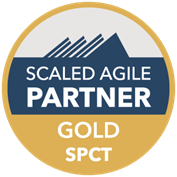Master Agile Practices With Comprehensive SAFe Accreditation
In a progressively intricate company landscape, understanding Agile practices through detailed SAFe qualification has actually emerged as an essential expertise for professionals aiming to improve business performance. As organizations look for to browse the challenges of fast adjustment, the implementation of SAFe principles uses a path to improved outcomes.
Comprehending SAFe Structure
The SAFe (Scaled Agile Structure) framework serves as an organized approach for executing Active techniques at scale across huge companies. It gives a comprehensive technique that straightens the different levels of an organization, from team to portfolio, making certain that all components work cohesively towards usual goals. SAFe integrates principles from Agile, Lean, and item development circulation, offering a distinct collection of responsibilities, methods, and duties.
At its core, the SAFe framework comprises four degrees: Group, Program, Huge Option, and Portfolio. Each level addresses specific aspects of Agile distribution, from managing little teams of developers to looking after numerous programs and lining up calculated efforts with service goals.
SAFe encourages cooperation amongst cross-functional groups, fostering an atmosphere where constant renovation and innovation are paramount. SAFe For Architects. By highlighting positioning, openness, and built-in top quality, the structure outfits organizations to respond swiftly to market adjustments while providing value to clients
In addition, SAFe sustains different methodologies, such as Scrum and Kanban, enabling organizations to tailor their method according to particular project needs. This versatility ensures a durable structure for organizations intending to grow in a rapidly progressing business landscape.

Benefits of SAFe Accreditation
Regularly sought after in the Agile community, SAFe accreditation provides many benefits for specialists and companies alike. One of the primary advantages is the enhancement of skills and understanding in applying the Scaled Agile Structure (SAFe), which equips people with the devices necessary to drive successful Agile improvements. This qualification indicates a commitment to professional development, making candidates much more competitive in the job market.
For organizations, having actually licensed specialists cultivates a society of continual improvement and collaboration, vital for adjusting to altering market needs. It enables groups to align their job with critical goals, eventually improving productivity and efficiency. Firms with a higher percentage of SAFe-certified staff members usually experience minimized time-to-market and increased quality of deliverables.
Additionally, SAFe accreditation helps with networking opportunities with other Agile practitioners, allowing the exchange of ideal experiences and methods (SAFe For Architects). This joint network can substantially add to organizational and individual growth. In recap, acquiring SAFe certification not just improves individual capacities however also reinforces the general Agile maturation of an organization, causing lasting success in today's vibrant business setting
Secret Elements of SAFe
Building on the benefits of SAFe certification, recognizing the crucial components of the Scaled Agile Structure is important for properly applying its principles. The SAFe framework comprises four main degrees: Team, Program, Large Remedy, and Portfolio. Each degree addresses various facets of active techniques, helping with alignment and shipment throughout the organization.
At the Team degree, cross-functional teams work collaboratively making use of Nimble techniques, such as Scrum or Kanban, to deliver step-by-step value (SAFe Lean Portfolio Management). The Program degree focuses on the Agile Launch Train (ART), which is a long-lived team of Agile teams that plans, dedicates, and implements together. The Huge Solution level addresses complicated remedies that call for several ARTs to operate in concert, making sure control and integration

Preparing for SAFe Certification
Preparing for SAFe certification calls for a critical method to ensure a thorough understanding of the framework. First, acquaint yourself with the core concepts and worths of the Scaled Agile Structure (SAFe) Evaluation resources given on the Scaled Agile site, consisting of the SAFe framework documents, study, and whitepapers, to develop a strong structure.

Furthermore, technique with sample examination inquiries to familiarize yourself with the layout and kinds of questions you may experience. Signing up with research study teams or forums can help with expertise exchange and provide support from fellow candidates.
Applying SAFe in Organizations
Carrying Out the Scaled Agile Structure (SAFe) within companies demands an organized approach that straightens groups and procedures towards a common goal. The successful application of SAFe begins with establishing a clear understanding of its principles, including partnership, alignment, and transparency. Organizations needs to first examine their present processes and recognize locations for renovation, guaranteeing they are all set for the social change that SAFe requires.
Training and accreditation for teams assist gear up participants with the needed abilities and knowledge to run successfully within the SAFe framework. This consists of developing Agile Release Trains (ARTs), which offer as the backbone for delivering company website worth throughout the company.
By regularly using SAFe principles and methods, companies can accomplish better agility, enhance partnership, and ultimately drive far better company results. Welcoming this framework settings organizations to react swiftly to market adjustments and consumer demands.
Conclusion
Finally, mastering Agile practices via detailed SAFe certification significantly contributes and improves expert capacities to business performance. The knowledge gained from understanding the SAFe framework, along with its essential elements, assists in effective improvements and enhances partnership among groups. Moreover, getting this accreditation settings people positively in a competitive job market, highlighting the significance of continuous renovation and placement within companies. Embracing SAFe inevitably causes enhanced efficiency and greater high quality deliverables.
The SAFe (Scaled Agile Framework) structure offers as a structured strategy for executing Active practices at range across big companies. One of the primary benefits is the improvement of skills and understanding in applying the Scaled Agile Framework (SAFe), which furnishes people with the tools required to drive effective Agile transformations. In summary, acquiring SAFe certification not just enhances private capacities yet also strengthens the general Agile maturation of an organization, leading to lasting success in today's dynamic company atmosphere.
Structure on the benefits of SAFe certification, understanding the vital elements of the Scaled Agile Structure is vital for efficiently applying its concepts.Implementing the Scaled Agile Structure (SAFe) within companies requires a structured strategy that lines up teams and procedures toward an usual goal.